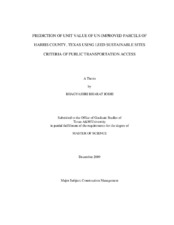| dc.contributor.advisor | Woods, Paul K. | |
| dc.creator | Joshi, Bhagyashri Bharat | |
| dc.date.accessioned | 2011-02-22T22:24:16Z | |
| dc.date.accessioned | 2011-02-22T23:48:14Z | |
| dc.date.available | 2011-02-22T22:24:16Z | |
| dc.date.available | 2011-02-22T23:48:14Z | |
| dc.date.created | 2009-12 | |
| dc.date.issued | 2011-02-22 | |
| dc.date.submitted | December 2009 | |
| dc.identifier.uri | https://hdl.handle.net/1969.1/ETD-TAMU-2009-12-7595 | |
| dc.description.abstract | Leadership in Energy and Environmental Design (LEED) is one of the environmental assessment tools available to gauge buildings. This rating system is a voluntary system which does not include financial aspects in the evaluation framework. This poses a challenge for encouraging land development projects, since developers consider financial or economic return as a crucial factor before building a project. It becomes essential to know if market really accepts the economic worth of LEED ratings. This research attempted to find out relationship between economic worth of a land and parameters (measurements), which are essential to earn LEED sustainable rating for public transportation access. To find out this relationship and to recognize power of the LEED measurements to predict the appraised value of a land (dollars per square foot) various statistical models were used and predictive equations produced.
The observational units were properties in Harris County, Texas that were unimproved and had zero improvement value. The dependent variable was unit value of the property measured in dollars per square foot. The independent variables were measurements that are required for a parcel to earn LEED sustainable site rating for public transportation access and the area of parcel.
Data regarding appraised values and land area were acquired from the Harris County Appraisal District and transportation data was obtained from Houston- Galveston Area Council.
Multiple regression analysis was used to analyze different models and to develop predictive equations.
Findings suggest that LEED green building rating system influences the appraised value, dollars per square foot, of properties. It further implies that market considers the economic effect of the LEED rating system even if this assessment method does not explicitly include financial aspects in the evaluation framework.
Findings of this research also suggest that a sustainable feature of a site is related to the economic worth of a related land development project. This will provide encouragement for new sustainable land development projects. This will provide an economic incentive to the owners and developers. Developers will get encouragement to select a site located closer to mass transit networks. | en |
| dc.format.mimetype | application/pdf | |
| dc.language.iso | en_US | |
| dc.subject | LEED Green Building Rating System | en |
| dc.subject | Economic worth of properties | en |
| dc.title | Prediction of Unit Value of Un-Improved Parcels of Harris County, Texas Using LEED Sustainable Sites Criteria of Public Transportation Access | en |
| dc.type | Book | en |
| dc.type | Thesis | en |
| thesis.degree.department | Construction Science | en |
| thesis.degree.discipline | Construction Management | en |
| thesis.degree.grantor | Texas A&M University | en |
| thesis.degree.name | Master of Science | en |
| thesis.degree.level | Masters | en |
| dc.contributor.committeeMember | Saginor, Jesse | |
| dc.contributor.committeeMember | Peterson, John | |
| dc.type.genre | Electronic Thesis | en |
| dc.type.material | text | en |


